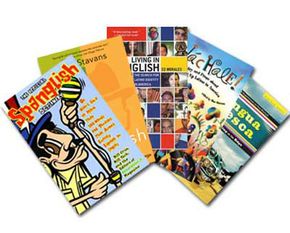Spanglish has a surprisingly long history. Stavans explains, "I would say that Spanglish isn't only a way of communication, although that is what people think of when they hear the world…it could be described as either the marriage or the divorce between two languages -- Spanish and English -- that have been with each other and at each other for over 150 years, if not more."
This 150-year figure may surprise people who think of Spanglish and immigration from Spanish-speaking countries into the United States as recent phenomena. But Spanglish has roots in the 1800s. Stavans explains:
In the middle of the 19th century, when the treaty of Guadalupe Hidalgo was signed, that is in 1848, a generous portion of the Mexican territory at that point was sold to the United States, and obviously with all the people that lived there. And those individuals, in what is today Arizona and Colorado and New Mexico and other parts of the Southwest, found themselves using Spanish at home but being forced to use English for business transactions and for legal issues, and in the public domain. So that is one major moment when these two languages started to come together and started to kind of struggle to see which one was the most powerful, eventually resulting, that tension, in a kind of a co-existence.
Other major encounters between English speakers and Spanish speakers have influenced Spanglish as well. "[There was] the Spanish-American war at the end of the 19th century, when Spain left the Caribbean and the Americans came into Cuba and Puerto Rico," says Stavans. "And Puerto Rico today is probably the cradle, together with the U.S.-Mexico border, the cradle of Spanglish, where this hybrid form of communication is used most often by most people. And then of course throughout the 20th century as American culture moved south…the connection between Spanish and English was once again reinforced." Spanglish may even have roots as early as the 17th and 18th centuries, when British travelers visited Spain.
Spanglish is not the first language hybrid to appear in the United States, but it has taken hold in a way that other similar ways of speaking have not. Stavans explains, "In many ways, one has to keep in mind that Spanglish is not unique, that every immigrant group that comes to a new culture or a new linguistic environment has to face the task of retaining, if that group is willing to, its connection with the immigrant tongue, but at the same time embrace the welcoming tongue, or the tongue of the new environment, and the tension between the two often results in all sorts of complications."
One hybrid that has appeared in the United States was a mix of Norwegian, and Danish, Finnish and English, called Finglish, at the end of the 19th and the beginning of the 20th century. In addition, says Stavans, "There was also something called Polinglish or Punglish, there's Chinglish, that is, every single group has, even for a very brief and disorganized moment, has produced a kind of hybrid, in-between language."
The in-between language created from English and Spanish has persisted and spread for a number of reasons. One reason, Stavans says, is geographic:
Whereas other groups, say the group from Finland, came into this country from many, many miles away in crossing a huge ocean, and they came in small numbers, for economic reasons. With Latinos, many of us are very close to the place once called home…Miami is only 90 miles away from Cuba. A flight from New York to San Juan, Puerto Rico is $75 on a good day, and if you live in Brownsville or in San Antonio and want to go to Mexico, that is the country of your past, it sometimes takes only 10 minutes or even less, depending on where you are.
In addition, immigration from Spanish-speaking countries has been ongoing and has involved large numbers of people. According to Stavans, "For a person from Finland, Finglish eventually disappeared because people simply stopped using it. No new immigrants were arriving and there were not enough speakers. With Latinos there is always a new group coming in that reminds us that Spanish is alive and kind of freshens the community's verbal skills."
Click the red dots to learn about the major milestones in the development of the English language. Click the arrow to see the rest of the timeline.
So geography, economy and the English and Spanish languages have had an enormous effect on Spanglish. But Spanglish also has the potential to affect Spanish and English, both of which have gone through numerous changes over hundreds of years. Spanish and English now sound very different from each other, but both are Indo-European languages. Along with many other European and southern Asian languages, they all grew from the same now-extinct language.
Today, English and Spanish are part of two different language families. English is a Germanic language that grew from languages spoken by Germanic tribes. Spanish is a Romance language, meaning that it grew from Latin. Both languages have had a number of influences during their histories as people who spoke them came into contact with other languages and cultures. The animations above and below will give you an overview of how other languages have affected Spanish and English.
Click the red dots to learn about the major milestones in the development of the Spanish language. Click the arrow to see the rest of the timeline.
Spanglish has grown from Spanish and English, and it may affect both languages dramatically in the future. However, Stavans describes Spanglish more than just a meeting of two languages. "More than anything else, it is proof that a new civilization is emerging before our eyes. A civilization that is part Hispanic, part Anglo, and in those two categories, it includes all sorts of other roots, to Africa, and to England, to parts of Europe, to the far East, and I think that what we are witnessing with Spanglish is the way people communicate verbally and otherwise, as they try to put together or negotiate the tension between these two cultures or these two ways of being, being a Hispanic or a Latino and an Anglo. And the result is a hybrid middle ground that is really the Spanglish way of being."
You can learn more about Spanglish, Spanish, English and related topics by checking out the links on the next page.

